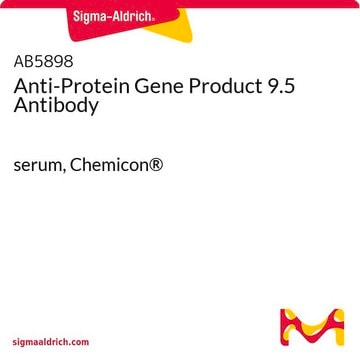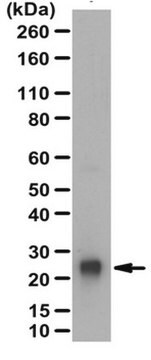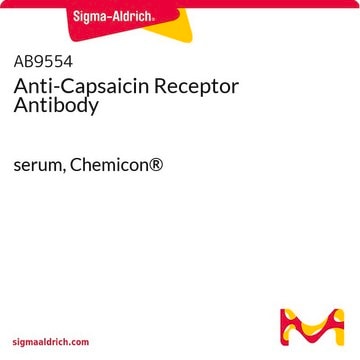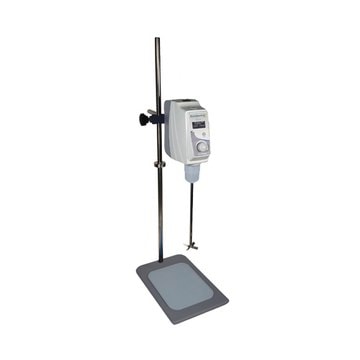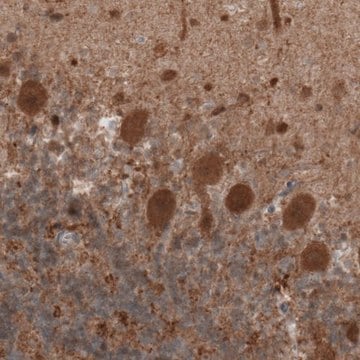AB5925
Anti-Protein Gene Product 9.5 Antibody
serum, Chemicon®
Synonym(s):
PGP 9.5, UCH-L1
Sign Into View Organizational & Contract Pricing
All Photos(1)
About This Item
UNSPSC Code:
12352203
eCl@ss:
32160702
NACRES:
NA.41
Recommended Products
biological source
rabbit
Quality Level
antibody form
serum
antibody product type
primary antibodies
clone
polyclonal
species reactivity
mouse, human, pig, rat
manufacturer/tradename
Chemicon®
technique(s)
immunohistochemistry: suitable
western blot: suitable
NCBI accession no.
UniProt accession no.
shipped in
dry ice
target post-translational modification
unmodified
Specificity
Protein Gene Product 9.5 (PGP9.5).
Immunogen
Synthetic peptide corresponding to amino acids 108-127 of soluble cytoplasmic human PGP9.5.
Application
Detect Protein Gene Product 9.5 using this Anti-Protein Gene Product 9.5 Antibody validated for use in WB, IH.
Research Category
Neuroscience
Neuroscience
Research Sub Category
Neuronal & Glial Markers
Neuronal & Glial Markers
Western blot: 1:1,000
Immunohistochemistry: 1:2,000
Optimal working dilutions must be determined by the end user.
Immunohistochemistry: 1:2,000
Optimal working dilutions must be determined by the end user.
Physical form
Liquid with 0.05% sodium azide.
Storage and Stability
Maintain at -20°C in undiluted for up to 6 months. Avoid repeated freeze/thaw cycles.
Legal Information
CHEMICON is a registered trademark of Merck KGaA, Darmstadt, Germany
Disclaimer
Unless otherwise stated in our catalog or other company documentation accompanying the product(s), our products are intended for research use only and are not to be used for any other purpose, which includes but is not limited to, unauthorized commercial uses, in vitro diagnostic uses, ex vivo or in vivo therapeutic uses or any type of consumption or application to humans or animals.
Not finding the right product?
Try our Product Selector Tool.
recommended
Product No.
Description
Pricing
Storage Class Code
10 - Combustible liquids
WGK
WGK 1
Certificates of Analysis (COA)
Search for Certificates of Analysis (COA) by entering the products Lot/Batch Number. Lot and Batch Numbers can be found on a product’s label following the words ‘Lot’ or ‘Batch’.
Already Own This Product?
Find documentation for the products that you have recently purchased in the Document Library.
J Sadeghinezhad et al.
Anatomia, histologia, embryologia, 42(3), 201-212 (2012-09-05)
Most investigations related to the characterisation of the enteric nervous system (ENS) are pivoted on the intestine of small rodents, but few studies are available on the ENS of wild or 'unconventional' rodents. Anti-PGP 9.5 and anti-Hu antibodies were utilised
Charles-Antoine Assenmacher et al.
The journal of histochemistry and cytochemistry : official journal of the Histochemistry Society, 69(3), 203-218 (2020-12-08)
The mouse line carrying the Tg(Tyr-NRAS*Q61K)1Bee transgene is widely used to model in vivo NRAS-driven melanomagenesis. Although the pathological features of this model are well described, classification and interpretation of the resulting proliferative lesions-including their origin, evolution, grading, and pathobiological
Haruyo Yamanishi et al.
Journal of anatomy, 242(6), 1012-1028 (2023-02-12)
Lanceolate nerve endings (LNEs) surrounding hair follicles (HFs) play an important role in detecting hair deflection. Complexes of the LNEs form a palisade-like structure along the longitudinal axis of hair roots in which axons are sandwiched between two processes of
Stacey Anne Gould et al.
Experimental neurology, 338, 113607-113607 (2021-01-19)
Chemotherapy-induced peripheral neuropathy (CIPN) is a common dose-limiting side effect of cancer treatment, often associated with degeneration of sensory axons or their terminal regions. Presence of the slow Wallerian degeneration protein (WLDS), or genetic deletion of sterile alpha and TIR
F A Kullmann et al.
Acta physiologica (Oxford, England), 222(2) (2017-07-19)
The mechanisms underlying detection and transmission of sensory signals arising from visceral organs, such as the urethra, are poorly understood. Recently, specialized ACh-expressing cells embedded in the urethral epithelium have been proposed as chemosensory sentinels for detection of bacterial infection.
Our team of scientists has experience in all areas of research including Life Science, Material Science, Chemical Synthesis, Chromatography, Analytical and many others.
Contact Technical Service